Originally published on Getting Smart.
For many years (at least until 2020), we visited about 100 innovative schools a year. It’s the most important form of professional learning we do for ourselves and for the educators that accompany us. It’s how we create and update a shared vision of powerful learning.
This page features some of the most innovative schools that exhibit best practices — schools that, on one or more dimensions, illustrate the path forward. We most appreciate practices, supports and environments that promote deep engagement. We’re most interested in schools that serve historically marginalized groups — or whose practices have the potential to promote equality at scale. This list is only a segment of the many great examples of learning that exist, and we are going to continue adding exemplars of deep learning experiences as we are made aware of them.
If you’d like to visit schools (physically or virtually) contact Jessica. If there is an innovative school that we should know about, send information to Info.
Elementary (K-6)
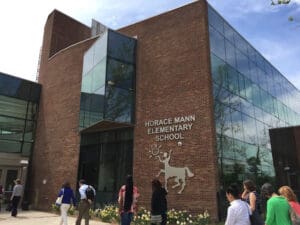
Classic Rehab. Horace Mann Elementary School, in northwest Washington D.C., is a joy-filled student-centered personalized learning environment serving a multicultural student body. The new and modernized historical facility reflects thoughtful programmatic values: Collaboration and Connection, Sustainability and Stewardship, and Choice and Invention. (See podcast with principal Elizabeth Whisnant.)
Project-Based. Epic Elementary School, Liberty Public Schools in north Kansas City, is a project-based school serving 300 learners in the renovated district office. EPiC features double classrooms and partner teaching. Many of these studios have big roll-up doors and share common space and quiet small group rooms. (See feature.)
Early Leadership. Mukilteo Elementary, north of Seattle, makes great use of the Leader in Me program to empower student leadership. They finish each year with a family portfolio picnic where they review quality student work. Students also help to develop a nature preserve with trails and a two-acre outdoor classroom. (See feature.)
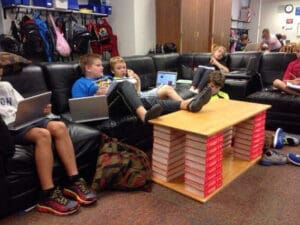
Microschool. KM Explore is one of four district-sponsored microschools west of Milwaukee. The open-plan multi-age blend features high engagement projects, place-based learning and collaborative teaching. They also figured out what to do with those old textbooks.
Mandarin IB. Wade King Elementary School in Bellingham, Washington features the IB Primary Years Program. Students have the opportunity to learn Mandarin and benefit from individualized instruction, access from home, and coaching from a native speaker.
K-8 Schools and Paired Elementary & Middle Schools

New Model. Design39, Poway School District in north San Diego County, is a spectacular K-8 school featuring design thinking and personalized learning. Check out this podcast episode with Joe Erpelding, formerly of Design 39 on why this is such a magical school and how they live into their motto: “Life ready thought leaders who elevate humanity.”
Team Taught PBL. The 200 school New Tech Network (NTN) includes a growing number of project-based, STEM-focused middle and elementary schools. The movement began in the Evergreen School District in San Jose with Katherine Smith Elementary, a joyful project-based school with a great student ambassador program. (See feature). Bulldog Tech is a purpose-built middle school with double classrooms ideal for integrated project-based learning. New Tech Network has a handful of the most innovative schools. (See feature.)
Career Education. Cajon Valley USD in east San Diego County features elementary and secondary schools that feature the World of Work in 54 immersive community-connected experiences that explore career options and conclude in reflection on strengths and interests (see feature). They have a great middle school career center developed with the San Diego Workforce Partnership.

Data-Driven. Cesar E. Chavez Multicultural Academic Center is a neighborhood P-8 in Chicago’s Back of the Yards neighborhood on the south side. Despite nearly 100% poverty and nearly half of the students new to English, the school has been a top academic performer in Chicago for a decade. Principal (and data ninja) Barton Dassinger was a teacher at Chavez and has kept a veteran staff focused on getting better every year.
Lit Magnet. Burley School is a Chicago literature, writing and technology magnet school. Visitors see students discussing, reading, thinking, exploring, questioning, experimenting, creating and collaborating. Students have access to iPads and laptops and a full art and music program.
Personalized Performing Arts CBE. Metropolitan Arts Academy, part of Westminster Public Schools in Denver, Colorado, is a visual and performing arts public innovation school that has a focus on artistic expression through project-based instruction within the context of visual and performing arts. This learner-centered environment with a rigorous competency based learning model, partners with artists, professional organizations, and community partners to provide authentic learning experiences.
4 Pillars. Caliber Beta opened in 2014 in Richmond, California, with personalized learning plans, a flexible rotation model for math and English and project-based learning for science and social studies. Four pillars include a safe and supportive environment (HEART) so that students can engage in rigorous learning (SMART) and develop the skill set to be critical thinkers (THINK) who then become agents of change in their communities and world (ACT). Students participate in computer programming, engineering and robotics classes.
Competency. Washington Elementary School, Lindsay Unified School District in California’s Central Valley, is a leading example of a personalized and competency-based K-8 school. Every student has a personal learning plan and sets daily goals–a great example of developing and engaging student agency and social emotional learning. (See podcast, and report.)
Montessori. Magnolia Montessori for All educates the whole child, focuses on leadership, embraces multiculturalism, and welcomes families as partners. The Austin muti-age P-8 charter school is organized in four grade spans.
Montessori. Urban Montessori Charter School in Oakland combines Montessori’s pedagogy with Design Thinking and Arts Integration in a multicultural community.
In Park. Environmental Charter School at Frick Park in Pittsburgh uses their theme to build systems thinkers, explore complexity and develop problem solving skills in a multidisciplinary, “out-the-door” learning approach that builds active, engaged, and empathetic citizens.
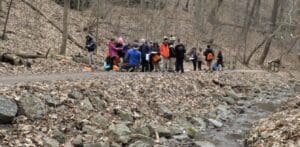
Chinese. Mandarin Immersion Magnet School in Houston features a state-of-the-art facility, cohesive culture, blended learning and student supports. Elementary students spend half of the day in a Mandarin class and the other half in an English class.
PRIDE. Ingenuity Prep opened in Southeast Washington, D.C in 2013. It helps PK-8 students develop civic leadership, strong relationships and a supportive community. Their “kid friendly” spell PRIDE: positivity, resilience, integrity, discipline and empathy.
Competency. New Emerson School is a demonstration site for Mesa County Valley School District 51, a district featured by CompetencyWorks for their high engagement transition to personalized and competency-based learning.
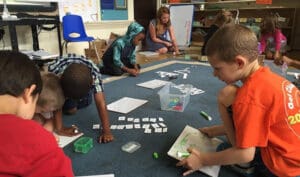
Art + Competency. Metropolitan Arts Academy is an Innovation School in Westminster Public Schools north of Denver. Visual and performing arts are integrated into a rigorous learner-centered and competency-based environment. Working with local artists and arts advocacy groups provides authentic learning experiences. (See podcast.)
Innovation. Bricolage Academy in NOLA is a multicultural, active learning K-8 school focused on creative problem solving. Teachers model design thinking and rapid iteration across the curriculum.
Homeschool Hybrid. DaVinci Connect is a TK-8 school in Hawthorne, California (profiled here) that combines homeschool with two days per week of on-campus project-based and social emotional learning.
Middle (6-8)

Greenfield Design. Achievement First operates 41 schools in Connecticut, New York, and Rhode Island. AF Providence Mayoral Academy is one of four Greenfield Design middle schools. Students create advisory “Dream Teams” for goal setting and support, enjoy enrichment opportunities, and have two-week expeditions in an area of interest every term.
Turnaround Network. Grant-Beacon Middle School is a transformed middle school in Denver featuring blended learning, character development, critical thinking and extended learning opportunities (featured here). Kepner-Beacon Middle School is the second school in the network (featured here). Both have great student ambassadors.
Middle and High Schools (6-12)
Equality for Underserved Learners. Brooklyn Laboratory Charter School serves low-income students in the heart of Brooklyn’s Tech Triangle. Rigorous academic courses are supported by small group tutoring, a college-ready culture, social-emotional learning and strong support particularly for learners with complex needs. LAB co-founded the Educating All Learners Alliance and has been a leader in pandemic precautions.
Competency. Highland Academy in Anchorage is a 6-12 learning environment that promotes mastery learning through integrated project-based learning. Guiding ideas include shared leadership, shared vision, and personal mastery through standards-based instruction with systemic and systematic continuous improvement (featured on CompetencyWorks).
STEM Partnerships. School of Innovation, part of Willoughby-Eastlake City Schools (east of Cleveland), is a 3-8 school (growing to 3-12) in a former corporate training facility.
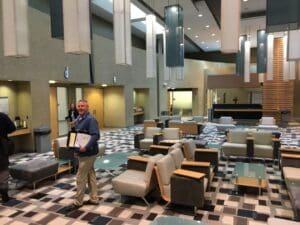
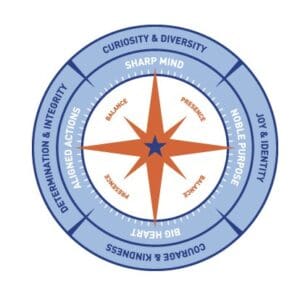
Compass Circles. Valor Collegiate Academies in Nashville has two middle schools and a high school powered by Compass, a human development model that is incorporated into the advisory system and rigorous academics. More than 50 schools have adopted the Compass. (See video.)
STEM + Values. Denver’s DSST may be the best open access STEM network in the country but it’s also a values-driven organization that incorporates six core values into everything they do. Visit the flagship Montview Middle and High School. (See feature.)
Language. Young Women’s STEAM Research & Preparation Academy in El Paso is the only dual language girls school in the New Tech Network which is known for team taught project-based learning.
Museum. Grand Rapids Public Museum School is a partnership between a museum, three colleges, the city, and the school district. The middle school is in a science museum (below) and the XQ winning high school is in a renovated art museum. Both feature design thinking and community connected project-based learning.
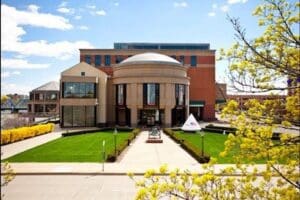
Learner-Centered. Making Community Connections (MC2) in Manchester, New Hampshire, is an innovative 7-12 school with two campuses that share an understanding of motivation, engagement and student agency. Experiences include personal learning, field experiences, internships and challenge activities. Students prepare portfolios and a presentation in order to pass through gateways onto the next phase. (See series and feature.)
Team-Teaching. Intrinsic Schools has two Chicago high schools that feature big integrated team-taught blocks in open pods with three teachers and 60 students who rotate between teacher-led instruction, independent and small-group work, and project-based learning. The Belmont campus is in a cool converted lumber yard and the new campus is in a downtown high-rise. (See feature.)
Design. Nuvu, in Cambridge Massachusetts, is an innovative microschool based on a project-based studio model led by coaches who are leaders in their industry, experts in varied fields, and passionate thought leaders. The independent school is developing a partner network through a fellowship program.

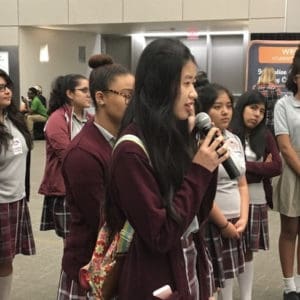
Leadership. Ann Richards School for Young Women Leaders serves 800 girls in grades 6–12 in Austin, Texas. The focus is on leadership, college readiness and STEM. Sophomores do a big project, juniors participate in an internship, seniors conduct a capstone project. All graduates attend college, most in STEM fields.
Women in STEM. Young Women’s College Preparatory Academy opened in 2011 in Houston in partnership with the Young Women’s Preparatory Network (one of eight other similar schools in Texas including Ann Richards School).
Community Center. Gary Comer College Prep and Gary Comer Middle School are part of the 18 school college prep focused Noble Network. They share a campus with Comer Youth Center and together they offer extended learning opportunities and youth and family supports. Campus and rooftop gardens support an urban agriculture program. (See feature.)
High School (9-12)
Internships. The Metropolitan Regional Career and Technical Center (Met) was founded in Providence in 1996 by Dennis Littky and Elliot Washor with the goal of teaching one kid at a time. Today the Met is six small Rhode Island public high schools and flagship of the Big Picture Learning network, a leader in internships, individual learning plans, and advisory systems. (See history and feature).
Early College + Internships. San Diego Met on the campus of San Diego Mesa College is a San Diego USD high school and member of the Big Picture Learning network. Learners take college classes three days a week and conduct internships two days a week.
Competency. Del Lago Academy, Escondido USD in north San Diego County, is a health sciences focused school featuring interdisciplinary projects. Business partners help define competencies and assess student work. To assess what students were doing throughout the scientific process they created Competency X, a badging system. (See tenth grade example, feature, op-ed, and podcast.)

Real-World Focus. Energy Institute High School in Houston is creating opportunities for students to engage with engineers and business leaders in the field of energy through high-quality project-based learning. (See feature.)
Design Thinking. Freshman at LEAD Innovation Studio in the Park Hill School District , north of Kansas City, learn design thinking and develop leadership skills. A new facility for the 2020-21 school years was designed to support collaborative, project based learning and display student work. (See feature and video of new facility.)
Network for Good. DaVinci Schools is a network of seven innovative Los Angeles schools including three campus schools just south of LAX. DaVinci Communication, Design, and Science are all good examples of personalized and project based learning. Each school has three career pathways rich with professions-based learning.
The DaVinci network also includes Connect (mentioned above) and XQ grantee RISE High, a unique three campus school helping youth navigate foster care, housing instability, probation and other complex challenges .
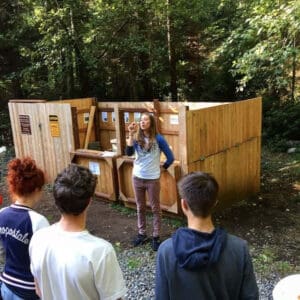
Playlists & Projects. Summit Everest in Redwood City is the flagship high school of Summit Public Schools (@SummitPS), a network of 16 schools in California and Washington. Through a nonprofit affiliate, nearly 400 schools use the Summit Learning platform which serves up individualized skill-building playlists and challenging projects. A student dashboard helps learners monitor progress and builds self-direction. (See podcast with founder Diane Tavenner.)
Coding. Washington Leadership Academy “graduate graduates are college-ready, have career-ready tech skills, and lead change in their communities and the world.” The DC school in an old seminary requires four years of computer science. (See feature and XQ profile.)
Art. Tacoma School of the Arts (SOTA), opened in 2001, is a great example of city-as-campus with theaters, museums, and a university as partners. Adjunct performers and artists support depth and application (See feature and feature.)
Zoo. Science and Math Institute (SAMI) at the Point Defiance Zoo in Tacoma is a great STEM school with built in zoo internships and outdoor science. They collaborate with SOTA (above) on academic and extracurricular opportunities. (See feature and feature.)
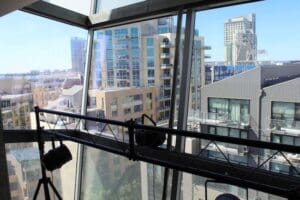
Library. e3 Civic High is located in San Diego’s high rise downtown library. Students learn through a mixture of self-paced online instruction, teacher or student-led small-group instruction, direct instruction, and problem-based and project-based work. They benefit from strong supports and extended learning opportunities.
Challenge. NYC iSchool combines core experiences (literature seminars, writing workshops, and scientific thinking and laboratory experiences), challenge-based modules (nine-week interdisciplinary courses developed around real-world challenges), online learning and advisory in support of core values of innovation, individualization and personalization, and metacognitive skill development. Students choose an Area of Focus as a junior and it guides course taking and a Senior Project.
Expeditions. Casco Bay High School in Portland, Maine is an EL Education school which keeps the school’s goals “clear, ambitious and essential.” Casco juniors engage in a long-term interdisciplinary project that results in demonstration of learning. (See 4 part series.)
Gradual release. Huntley High School, northwest of Chicago, features a blended learning program where teachers set the number of days in class needed from week to week depending on how the class is doing, or how individual students are progressing. Students can study in the HUB in individual or team spaces. (See feature and podcast with Superintendent Scott Rowe.)
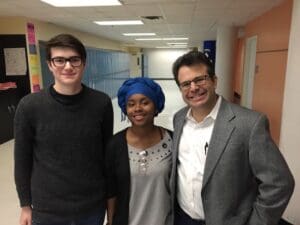
Inquiry. Science Leadership Academy is an inquiry-driven, STEM-focused, project-based school formed as a partnership between the School District of Philadelphia and The Franklin Institute. Shared instructional values of inquiry, research, collaboration, presentation and reflection are evident in every classroom. (See feature.)
Alternative. Eagle Rock in Estes Park, Colorado, is an initiative of American Honda, is both an alternative residential high school and a professional development center for educators–and a beautiful place to visit. (See podcast.)
Competency-Based. Building 21 operates public high schools in Philadelphia and Allentown and has four network affiliate schools. The personalized learning model (below) features problem-based learning, real work experiences, and competency-based assessments. (See 2020 feature, 2018 feature, and 2018 description.)
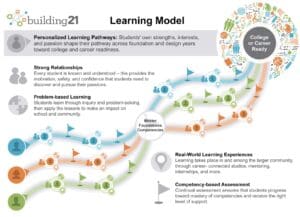
Art+. While in Boston, visit Boston Arts Academy which creates great art learning and exhibition opportunities with the Professional Arts Consortium and other community partners. It cohabitates with Fenway High, another great small school.
Alt Mashup. Boston Day and Evening Academy has proficiency-based pathways that allow students to progress based on demonstrated mastery rather than seat time. Students benefit from wraparound services, digital tools that help create a personalized approach, and a school open 12 hours a day. Self-paced alternative ed meets adventure-based leadership training meets blended learning. (See feature.)
Early College. Bard College at Simon’s Rock is “a small, selective, supportive, intensive college of the liberal arts and sciences in the middle of the Berkshires.” Students enroll after 10th or 11th grade. Simon’s Rock was the basis for the seven school Bard Early College network, where students can leave high school with an Associate’s Degree and an leader in the early college movement.
Service. Sconzo Early College High School in Humble ISD (north of Houston) has a great student-led service learning program. About 40% of graduates (many first generation college goers) earn at least one year of college credit and 25% leave with a high school diploma and an AA degree. (See podcast.)
Early College STEM. Metro Early College High School was launched in 2006 in partnership with the Ohio State University and Battelle. Students tackle big ideas, do real work, and take classes at OSU. Metro anchors the Ohio STEM Learning Network. (See feature.)
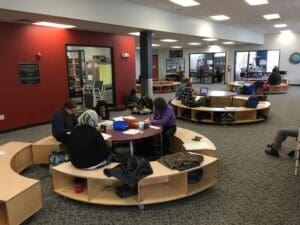
Micro Kickstart. Kettle Moraine School District west of Milwaukee kickstarted its transformation by developing three small schools inside a comprehensive high school: KM Perform with a performing arts focus, KM Global, a global studies school, followed by the School of Health Sciences. A remodeled facility created collaborative learning spaces that better support personalized learning in the academies and the comprehensive school. (See 2020 podcast and 2018 feature.)
Tech Jobs. IBM launched the Pathways in Technology Early College High School (P-TECH) in Brooklyn in 2011 in partnership with CUNY and City Tech. The model combines early college and tech work experience and has been replicated to more than 200 innovative schools with more than 600 industry partners. Sarah E. Goode STEM Academy in Chicago is a good example (See 2021 podcast and 2017 feature).
Work Study. Cristo Rey Jesuit High School in Chicago anchors the 37 school network of Catholic schools. Students take a full college prep course load and work one day each week in a Corporate Work Study Program to fund the majority of their tuition. Initiated out of financial desperation, the work study builds valuable success skills and work experience.
Advanced Manufacturing. RAMTEC in Marion, Ohio (an hour northwest of Columbus) at Tri-Rivers Career Center runs career and technical high school programs in advanced manufacturing, engineering technologies and welding. Through corporate partnerships, RAMTEC is able to offer high school students, community college students and adult workers some of the most current job training in the country. With a state grant, RAMTEC developed a network of 23 sites around Ohio .(See feature.)
Career High. Dubiski Career High in Grand Prairie ISD (between Dallas and Ft Worth) offers 15 career pathways in three academies: business and communications, health science and engineering, and human services and transportation. Most of the students have internships and more than half of these are with organizations outside of Grand Prairie. The school provides transportation to the internships, while also providing six on-site enterprises. (See feature.)
Finance. Southwest Miami High Academy of Finance, a member of the NAF network, has a 17-year track record of business partnerships that support student work experiences. The problem-based curriculum prepares students for careers in finance and includes dual enrollment courses.
Hospitality. Alonzo and Tracy Mourning Academy of Hospitality & Tourism in North Miami is also an NAF academy. Every student completes a 150-hour internship between their Junior and Senior years. The school has a productive dual enrollment relationship with the adjacent Chaplin School of Hospitality and Tourism at Florida International University.
Miami-Dade offers 58 NAF academies in the five career themes of Engineering, Finance, Health Science, Hospitality & Tourism and Information Technology. (See feature on NAF.)
Design. Design Tech High School (d.tech) on the Oracle campus blends design thinking with a focus on success skills to help students forge an identity that will help them as students, professionals, and citizens. (See podcast tour.)
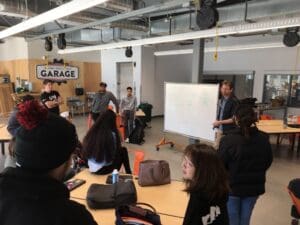
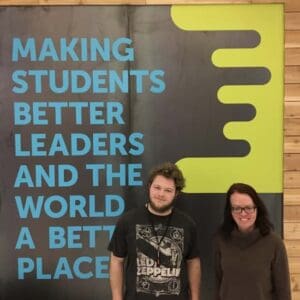
Design for Good. After a decade of innovative after-school and summer learning experiences, Boise nonprofit One Stone opened Lab51, a small innovative high school to help young people make the world a better place. (See design summary, feature, video and 2021 results from advisory pilot.)
Learner Centered Portfolio. Latitude High School has intentionally designed their offerings, schedule, and curriculum around a thorough set of competencies. Students develop and refine these competencies through community-engaged project-based learning, and graduate with a portfolio of accomplishments and work products to back up their learning.
Competencies that Matter. Purdue Polytechnic High School, created in partnership with Purdue University, awards credit based on student attainment of competencies. The school’s schedule is organized around 6-week project cycles in which teachers “pitch” projects and students are able to select projects based on their interests and needed competencies. The school’s agreement with the University means that all students are able to graduate credit toward Purdue University, and almost all do. (See feature.)
Community Connected. Students at Crosstown High spend most of their school day on the fourth and fifth floor of Crosstown Concourse, a million-square-foot renovated Sears office and distribution center opened in 2017 just east of downtown Memphis. The building is home to health providers, universities, theaters, businesses and retailers that support Crosstown projects and internships. Learners at the XQ grantee school progress on 12 competencies. (See feature and XQ profile.)
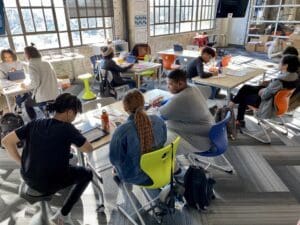
Humanities. Humanities Preparatory Academy is one of hundreds of new small coherent high schools formed in New York City in the last decade. Launched in 1997 with support from New Visions for Public Schools, the Humanities Prep team embraced a mission “to provide a philosophical and practical education for all students, an education that features creativity and inquiry, encourages habitual reading and productivity, as well as self-reflection and original thought.” As a democratic community, they strive to exemplify the values of democracy: mutual respect, cooperation, empathy, the love of humankind, justice for all, and service to the world. It’s also a member of the New York Performance Standards Consortium.
ELL. Bronx International High School, opened in 2004 as part of the NYC small schools initiative, was the fourth school in the Internationals Network for Public Schools which serves immigrant youth new to English. The network of 18 schools integrates language development and academic content while building student and family capacity for integration into American society. (See feature.)
Young Men of Color. EPIC North is one of three New York City schools opened in 2014 as a result of the Open Society sponsored Expanded Success Initiative designed to make sure that young men of color will thrive. As the EPIC Playbook describes, it combines competency education with youth development, cultural relevance and high engagement learning. (See feature.)
Essential. Francis W. Parker Charter Essential School, west of Boston, has been in the vanguard of progressive, student-centered public education for over twenty years. It’s based on the beautiful design principles from the Coalition of Essential Schools including “learning to use one’s mind well, less is more, goals apply to all, personalization, student as worker, demonstration of master, tone of decency, and democracy and equality. (See Springpoint profile.)
Flexibility. iLEAD Academy is a small blended and project-based high school with career connections and college credit opportunities. It’s located in a converted strip center an hour north of Louisville. (See feature and podcast.)
Coding. Phoenix Coding Academy, part of Phoenix Union High School District, focuses on computer coding and multiple technology pathways through an inquiry-based instructional design. Students address big problems and learn how to use computation as part of the solution.
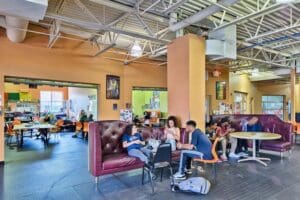
Urban. Urban Academy Laboratory High School uses performance-based assessment tasks as graduation requirements. The school was a founding member of the New York Performance Standards Consortium that share a rich performance assessment system. It was approved as an alternative to state tests by the Board of Regents in 1995 and reaffirmed in 2008 when additional schools were added (see feature). Founder Ann Cook negotiated an early and nationally visible co-location of six schools at the Julia Richmond Education. Cook also co-founded the NY State Standards Performance Consortium. (See our feature.)
Hip Hop High. High School for Recording Arts, a public school in St. Paul, pioneered the concept of connecting with at-risk students through music and related businesses. It helps young people develop agency and change-making skills to tackle real-world problems. For the full backstory, see Hip Hop Genius : Remixing High School Education by Sam Seidel (at Stanford d.school) and check out the facility designed by Fielding International.
K-12 Schools and Systems
Multiple model university high school partnerships: ASU Preparatory Academy in Phoenix, AZ is a multi-modal network of public charter schools that offers a range of options from on-site to full virtual through ASU Prep Digital. With options of hybrid microschools located on the campus of ASU, students begin their college journey during high school. Additional options are available through a partnership with Khan Academy via the virtual Khan World School.
Show & Tell. High Tech High has 16 schools on four campuses in San Diego County. They are all world class examples of integrated project-based learning and spectacular student art.

PBL District. Winton Woods City Schools, in northern Cincinnati, serves students living in poverty. With support from a state-level innovation grant, the district adopted the team taught project-based approach from the New Tech Network. (See Winton Woods feature and El Paso feature.)
Equality & PBL. iLEAD is a Southern California network where students are learners and teachers are facilitators. They focus on high quality project-based learning and recently have doubled down on racial inequality. (See PBL feature and feature on fighting inequality.)
Progressive. Harlem Village Academies is a progressive PK-12 public charter school network that creates learning experiences that inspire and require the highest levels of intellectual sophistication.

Hero’s Journey. Acton Academy is a student-centered K-12 microschool in Austin that spurred more than 200 global replications. The promise is that through Socratic dialogs and experiential learning, each member of the Acton community will begin a Hero’s Journey and discover precious gifts and a commitment to mastery. Learners take on real world projects and life changing apprenticeships. (See feature and podcast.)
Real World Learning. Crossroads Preparatory Academy is a Kansas City high school featuring project-based learning, internships and service learning. It is fed by two K-8 that value authentic learning and have a creative culture. The Crossroads system is a leader in the Kauffman Foundation sponsored Real World Learning initiative.
Interest-Based Learning. Minnesota New Country School opened a teacher-powered learner-centered secondary school west of Minneapolis in 1994 with the goal of leveraging the power of purposeful relationships, community, student-led project-based learning, and experiential education. An elementary school was added in 2013. MNCS spurred development of the Edvisions network of small teacher-led schools featuring self-directed project-based learning and authentic assessment.
World Class Focus. Northern Cass School District believes every learner can change the world and is committed to providing a “world class education.” This work led to collective commitments that shape all systemic design and budget decisions. Their emphasis on relationships helps to drive continuous improvement, strong instructional practice, self-reflection, and playing off personal strengths.
Eastbay Maker. Lighthouse Community Charter School, a multicultural K-12 community, is fast becoming Oakland’s leader in Maker Education through the great work of their Creativity Lab. They believe “young people have the potential to become lifelong changemakers who realize their unique vision — rooted in their identity, knowledge, and skills — to create equality in their own lives and in the community, leading to a healthier, more joyful world.”
Liberal Arts. Renaissance Academy is a K-12 public charter school in Phoenixville, 30 miles northwest of Philadelphia. Co-located with several businesses and educational service providers in a mixed-use factory redevelopment known as Franklin Commons, it serves 1,060 students. The longer day and year support a strong advisory program, AP and dual enrollment courses, and service learning. (See feature.)
Tutoring. Match Schools in Boston serves 1,250 students on three campuses with daily individual and small group tutoring for every student and an extended day. The schools are also supported by The Charles Sposato Graduate School.
College Completion. University Academy in Kansas City sends all of its graduates to four-year universities—and is working to ensure that they all graduate. The top performing Missouri school features international travel, drama, music, debate and strong extracurriculars. (See case study and podcast.)
Statewide. Virtual Learning Academy (VLACS) is New Hampshire’s competency-based online school with 30,000 course enrollments. Founded in 2007, it has served predominantly part time high school learners with a variety of courses, projects, and experiences that develop and demonstrate more than 300 competencies (see learning catalog). Funding is based on mastery rather than time. VLACS added Added elementary services in 2020.
Place-Based Education. Teton Science Schools in Wyoming is the leader in place-based education including K-12 school, outdoor education, a graduate school, and a national network.
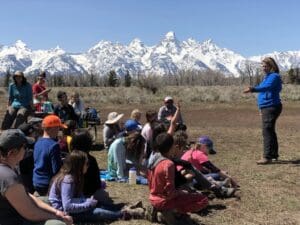
Part Time Programs
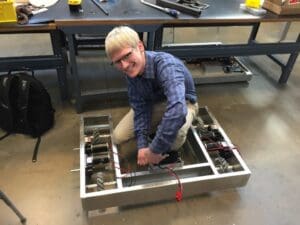
Professions-based Learning. The Blue Valley Center for Advanced Professional Studies (CAPS), south of Kansas City, takes an innovative business-partnership approach to giving its students professional and business skills that help them succeed in a range of industries. A national affiliate program, CAPS Network, has grown to about 75 school districts. (See podcast and feature.)
High Tech Learning. Summit Technology Academy is a half-day program in Lee’s Summit, southeast of Kansas City. It shares a state of the art facility on the Missouri Innovation Campus with the University of Central Missouri. It offers tech and health pathways with college credit and real world learning opportunities.
Community Connected Projects. Iowa BIG students from four partner school districts to two Cedar Rapids locations for a half-day program where students learn core academics and 21st century skills through authentic projects connected to community partners. (See podcast and feature.)
International Schools
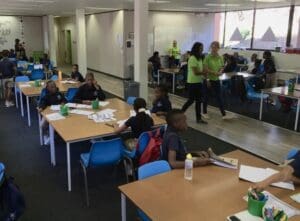
Low Cost Private. Inspired in 2012 by visits to American school networks, two MBA students launched SPARK Schools and developed 17 schools in Johannesburg and Cape Town featuring blended and extended learning and design thinking.
Dual Immersion. La Paz Community School is a PK-12 school that focuses on place-based education, culturally responsive curriculum and dual immersion on two campuses in northwest Costa Rica.
Active Learning. Singapore American School. A great school takes a “culture of excellence, possibility and extraordinary care,” said former superintendent Dr. Chip Kimball–and SAS is one of a handful of schools that does all three well. Through school visits and PLCs, the 4000 student school was transformed from a school with great test scores to a place that is preparing great people. (See case study, a feature on facilities, and podcast.)
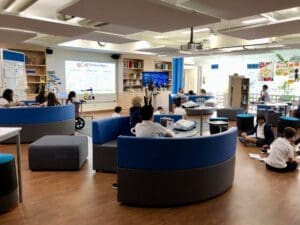
Green. The Green School in Bali combines a rigorous K-12 core curriculum with hands-on experiential learning within a Green Studies curriculum and a Creative Arts curriculum. Check out the spectacular bamboo architecture. It’s a boarding school, so you could send the kids and visit a couple times a year.

Student-Centered Design. The American School of Paris features design studios and projects in 1:1 classrooms that promote creativity, innovation and connected learning.The leadership team is adopting broader measures of success, supporting more student-centered learning experiences, and striving to make the campus even more supportive. (See feature and podcast.)




























